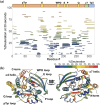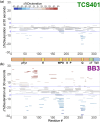Native dynamics and allosteric responses in PTP1B probed by high-resolution HDX-MS
- PMID: 38801229
- PMCID: PMC11129624
- DOI: 10.1002/pro.5024
Native dynamics and allosteric responses in PTP1B probed by high-resolution HDX-MS
Abstract
Protein tyrosine phosphatase 1B (PTP1B) is a validated therapeutic target for obesity, diabetes, and certain types of cancer. In particular, allosteric inhibitors hold potential for therapeutic use, but an incomplete understanding of conformational dynamics and allostery in this protein has hindered their development. Here, we interrogate solution dynamics and allosteric responses in PTP1B using high-resolution hydrogen-deuterium exchange mass spectrometry (HDX-MS), an emerging and powerful biophysical technique. Using HDX-MS, we obtain a detailed map of backbone amide exchange that serves as a proxy for the solution dynamics of apo PTP1B, revealing several flexible loops interspersed among more constrained and rigid regions within the protein structure, as well as local regions that exchange faster than expected from their secondary structure and solvent accessibility. We demonstrate that our HDX rate data obtained in solution adds value to estimates of conformational heterogeneity derived from a pseudo-ensemble constructed from ~200 crystal structures of PTP1B. Furthermore, we report HDX-MS maps for PTP1B with active-site versus allosteric small-molecule inhibitors. These maps suggest distinct and widespread effects on protein dynamics relative to the apo form, including changes in locations distal (>35 Å) from the respective ligand binding sites. These results illuminate that allosteric inhibitors of PTP1B can induce unexpected changes in dynamics that extend beyond the previously understood allosteric network. Together, our data suggest a model of BB3 allostery in PTP1B that combines conformational restriction of active-site residues with compensatory liberation of distal residues that aid in entropic balancing. Overall, our work showcases the potential of HDX-MS for elucidating aspects of protein conformational dynamics and allosteric effects of small-molecule ligands and highlights the potential of integrating HDX-MS alongside other complementary methods, such as room-temperature X-ray crystallography, NMR spectroscopy, and molecular dynamics simulations, to guide the development of new therapeutics.
Keywords: HDX‐MS; X‐ray crystallography; allostery; mass spectrometry; protein dynamics; protein structure; structural bioinformatics.
© 2024 The Authors. Protein Science published by Wiley Periodicals LLC on behalf of The Protein Society.
Figures






Update of
-
Native dynamics and allosteric responses in PTP1B probed by high-resolution HDX-MS.bioRxiv [Preprint]. 2023 Nov 13:2023.07.12.548582. doi: 10.1101/2023.07.12.548582. bioRxiv. 2023. Update in: Protein Sci. 2024 Jun;33(6):e5024. doi: 10.1002/pro.5024. PMID: 37503000 Free PMC article. Updated. Preprint.
Similar articles
-
Native dynamics and allosteric responses in PTP1B probed by high-resolution HDX-MS.bioRxiv [Preprint]. 2023 Nov 13:2023.07.12.548582. doi: 10.1101/2023.07.12.548582. bioRxiv. 2023. Update in: Protein Sci. 2024 Jun;33(6):e5024. doi: 10.1002/pro.5024. PMID: 37503000 Free PMC article. Updated. Preprint.
-
HDX-MS reveals orthosteric and allosteric changes in apolipoprotein-D structural dynamics upon binding of progesterone.Protein Sci. 2019 Feb;28(2):365-374. doi: 10.1002/pro.3534. Epub 2018 Dec 20. Protein Sci. 2019. PMID: 30353968 Free PMC article.
-
Hydrogen/Deuterium Exchange and Nuclear Magnetic Resonance Spectroscopy Reveal Dynamic Allostery on Multiple Time Scales in the Serine Protease Thrombin.Biochemistry. 2021 Nov 23;60(46):3441-3448. doi: 10.1021/acs.biochem.1c00277. Epub 2021 Jun 23. Biochemistry. 2021. PMID: 34159782 Free PMC article.
-
Measuring the hydrogen/deuterium exchange of proteins at high spatial resolution by mass spectrometry: overcoming gas-phase hydrogen/deuterium scrambling.Acc Chem Res. 2014 Oct 21;47(10):3018-27. doi: 10.1021/ar500194w. Epub 2014 Aug 29. Acc Chem Res. 2014. PMID: 25171396 Review.
-
An overview of hydrogen deuterium exchange mass spectrometry (HDX-MS) in drug discovery.Expert Opin Drug Discov. 2017 Oct;12(10):981-994. doi: 10.1080/17460441.2017.1363734. Epub 2017 Aug 17. Expert Opin Drug Discov. 2017. PMID: 28770632 Review.
Cited by
-
Allosteric regulation of the tyrosine phosphatase PTP1B by a protein-protein interaction.bioRxiv [Preprint]. 2024 Nov 11:2024.07.16.603632. doi: 10.1101/2024.07.16.603632. bioRxiv. 2024. Update in: Protein Sci. 2025 Jan;34(1):e70016. doi: 10.1002/pro.70016. PMID: 39071364 Free PMC article. Updated. Preprint.
-
TRAMP assembly alters the conformation and RNA binding of Mtr4 and Trf4-Air2.Proc Natl Acad Sci U S A. 2025 Jan 7;122(1):e2414980121. doi: 10.1073/pnas.2414980121. Epub 2025 Jan 3. Proc Natl Acad Sci U S A. 2025. PMID: 39752526 Free PMC article.
-
Mapping allosteric rewiring in related protein structures from collections of crystallographic multiconformer models.bioRxiv [Preprint]. 2025 May 27:2025.05.23.655529. doi: 10.1101/2025.05.23.655529. bioRxiv. 2025. PMID: 40501656 Free PMC article. Preprint.
-
Orchestrating function: Concerted dynamics, allostery, and catalysis in protein tyrosine phosphatases.Curr Opin Struct Biol. 2025 Aug 1;94:103125. doi: 10.1016/j.sbi.2025.103125. Online ahead of print. Curr Opin Struct Biol. 2025. PMID: 40752367 Free PMC article. Review.
-
Structures of human PTP1B variants reveal allosteric sites to target for weight loss therapy.bioRxiv [Preprint]. 2025 Mar 8:2024.08.05.603709. doi: 10.1101/2024.08.05.603709. bioRxiv. 2025. PMID: 39149290 Free PMC article. Preprint.
References
MeSH terms
Substances
Grants and funding
LinkOut - more resources
Full Text Sources
Miscellaneous

